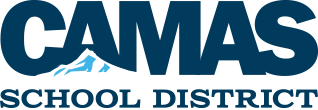-
A multidisciplinary selection committee (MDSC) made up of teachers, specialists, and administrators reviews multiple indicators of a student’s aptitude and achievement to determine whether the student is in need of Highly Capable Services. Camas School District does not use “cut scores” to determine eligibility. Data reviewed for students in grades 2 and above includes, but is not limited to, scores from the CogAT, iReady, state testing, teacher recommendations, and any supplemental information submitted by families. The committee looks for a consistent pattern of performance across BOTH achievement and aptitude indicators that is in the top 5-8 percent of students across the district.
The CogAT is a different type of test than achievement tests like the iReady. The iReady measures the math and reading that a student knows and can do, whereas the CogAT is a cognitive test with problems that do not look like other math or reading questions the student may have encountered and does not measure what the student has learned. The CogAT also does not measure such factors as effort, attention, motivation, and work habits, which also contribute significantly to school achievement. The CogAT, instead, measures mathematical/quantitative and verbal reasoning in a more abstract way. The MDSC uses local norms and looks at Age Percentile Ranking of the CogAT and the individual raw scores for each of the three subtests to help determine eligibility in ELA and/or math.
-
Often, when a family is asking this question, the student has scored above the 98th percentile on one part of an assessment. Again, the committee looks for a consistent pattern of performance across BOTH achievement and aptitude indicators that is in the top 5-8 percent of students across the district. Camas reviews multiple indicators of a student’s aptitude and achievement, not just test scores, to determine whether the student is in need of Highly Capable Services. Some students may be high-achieving, but may not demonstrate the kind of abstract thinking and reasoning skills that indicate a student is gifted/highly capable and in need of different instruction than that provided in our general education program. The abstract reasoning assessed by the CogAT is correlated to giftedness and success in the Highly Capable Program and students who are high-achieving are not necessarily highly capable. The results of district assessments in reading and math may indicate students are performing at or above grade level in some areas. However, the Multidisciplinary Selection Committee may have determined that your student would continue to be successful with current classroom instruction and is not in need of Highly Capable Services at this time.
-
Many students have inconsistent score profiles. This indicates that students have a strength or aptitude in one particular area. This is not uncommon, and it is why Camas identifies and serves students in a single area.
For younger students, their cognitive development may be proceeding more rapidly in one area than another and may become more consistent as the student continues to grow and develop. Many of our younger students have higher scores in one area than in the other or have higher scores on academic achievement tests than on tests of cognitive aptitude. Developmentally, high-achieving students may just not have developed abstract reasoning ability yet.
-
Yes, she can test during the next testing opportunity in just one area.
-
The appeals process is designed for families who believe that there was a specific circumstance that prevented their student from performing up to their ability during the testing session. Families receive information about appeals when they are notified of their student’s eligibility for services. If you feel that this determination may be in error due to a misinterpretation of testing results or your student’s assessment results were affected by an extraordinary circumstance during testing, we hope you will access our appeals process. If not, your student may participate in the screening process again next year.
Any family can choose to have their child participate in the winter screening and assessment. Referral for this testing occurs in November and can be found on the Highly Capable section of the district website. Families of students with uneven score profiles or whose student qualified in only one area often retest the following year.
-
The district is working toward improving equity and diversity in HiCap by:
- Eliminating HiCap testing on Saturdays and instead providing testing during the school day, in each school building.
- Reviewing multiple indicators and evidence of students’ abilities, in addition to HiCap test scores.
- Communicating to families in multiple languages and modes.
- Testing new Camas students in summer.
- Universally screening all 2nd and 5th graders.
-
ELA classes have a cluster of students identified as Highly Capable in a general education setting. The purpose of the HiCap ELA cluster option is to provide an opportunity for HiCap-identified students to be grouped together with their peers for social/emotional connections. Teachers will differentiate instruction in the classrooms. Math compacting/acceleration is offered starting in the 7th grade. Students can opt to cover 7th and 8th grade standards in one year and enroll in algebra as an 8th-grader. High school will still offer College in the Classroom, Running Start, and AP classes. There are also external online courses that may be eligible for graduation credit.
-
The district provides ongoing support and professional development for HiCap building leads, principals, and program teachers. The HiCap Coordinator and building leads provide job-embedded support and follow-up, as needed, for teachers in each building, including planning support, model teaching, feedback, or analysis of student work/data and subsequent planning to meet needs. We also support teacher attendance at professional conferences such as WAETAG and NAGT.
-
All of our elementary teachers with HiCap clusters are provided training in effective strategies for HiCap students. In some cases, their grade level teachers may teach all their subjects to their students. In some cases, students may have a teacher for each academic subject.
-
Yes. Once a child is identified or grades 2 and above, they are eligible for HiCap services in any future school year.
-
Yes. Each September we have presentations for parents and staff to learn together about highly capable students and how best to support them. Periodically we offer book studies for parents and have guest speakers.
-
Students who have been identified and served in other districts must be referred during the New Student Referral or the November Referral window. Each school district in Washington is able to design a screening, testing, and qualification process that matches the district board’s mission and vision. Highly capable services are not transferable from district to district. The continuum of services each district designs is unique to that district, although there are some similarities such as programs with pull-out services and self-contained classrooms. Camas and its neighboring districts have different programs that are unique to their board mission and vision, and to the communities they serve. Finally, and most importantly, Camas School District wants to ensure that all students are properly placed and getting the level of instruction and rigor they need.













